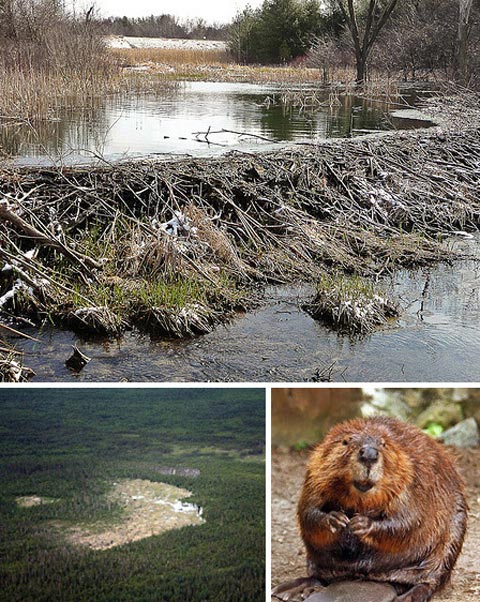The 'architectural masterpieces' of animals
Looking at the great construction works that few people expect to build, they are extremely small animals.
1. Large dam of beaver species

Beavers are animals with thick hair and large teeth, known for using wood, mud and rock to build dams. It acts as a moat to protect their families, preventing predators such as foxes, foxes, wolves and bears and makes them easy to get food in the winter. This is also the nest of a beaver family. Every day, they will constantly reinforce and expand their dams.
The record for the largest dam in the world by construction beaver has been recorded about 850m long in Wood Buffalo National Park, Canada. This can be said to be the largest animal's structure on Earth and especially the giant dam can be seen in images taken from outer space satellites.
2. 'Super city' of termite species

In the wild, termite nests are large towers built from soil, mud, woody items and even from their droppings with the maximum height of up to 7.5m, diameter of about 12m and heavy to hundreds ton. In a termite nest, the princess termites are about 30 times the size of workers, soldiers, and sometimes they lay up to more than 30 eggs in a minute to help maintain their empire.
Under those giant towers, there is also a large kingdom in the underground with complicated scales, there are separate areas for mushroom cultivation, ensuring self-sufficiency.
The most impressive point of the termite cave is the tunnel system with the effect of being a conduit for air conditioning and temperature, a big idea that people will pay attention to later in their buildings.
3. Underground city of mole rats

The mole's cave can actually be called a city with hundreds of meters in length and a capacity of thousands of 'inhabitants' at the same time. Here, they store a large amount of food to ensure their daily needs.
The most impressive feature of this natural project is that the city planning is well organized with a separate room system with bedrooms, a warm room in the winter and even a place to hold baby moles. The rooms have small niches to help ventilation and air conditioning.
The risk of flooding is also prevented when they have embanked dikes around the mouth of the cave to ensure safety. In addition, they arranged the guardians at the mouth of the cave to prevent unexpected enemies from attacking. If there are suspicious signs, they will transmit signals to alert and strengthen defenses.
4. Super giant spider web

Spiders are solitary species and often live far away from each other to avoid conflicts so we rarely see many spiders in the same place ever. However, on the rare occasions where they combine together to 'fight' the results are astounding with giant spider webs spread all over trees and things within coverage. It is thought that the cause may be caused by heavy rain, which causes the insects to eat abundantly, therefore, the spiders have chosen to cooperate to harvest this heavenly trophy.
5. Giant ant nests

The largest ant nest ever discovered is in Europe with a length of more than 6,400 km with a number of trillions. We all know that ants are extraordinary animals that can carry things several times their body weight but do not know they are great architects.
Look at their underground ants' buildings to see all this greatness. As the ant nest on the picture has an area of 46m2, depth up to 7.5m and needs nearly 40 tons of mud to complete with numerous numerous small caves and tributaries.
6. Bird's nest 'sustainable with time'

The Hilton family of finches, often living in Asia and Africa, is one of the most friendly bird breeds in the world and is also known to have the largest nest. Instead of building individual teams, about 300 pairs of sparrows join hands to build a giant nest with a width of 6m and a height of 2.5m, in which each small apartment is reserved for a couple.
Such nests are extremely solid and can last for hundreds of years. The organized, complex and timeless organization of these bird nests is indeed an architectural masterpiece of the natural world.
7. The 'standard' comes perfectly in the structure of the honeycomb

It can be said that this is an amazing masterpiece of worker bees with unexpected accuracy. Even the construction process is a feat when the worker bees produce warm pieces of beeswax just as small as the tip of a needle and then work hard to create a network of countless small squares. pillars with 6 faces are arranged vertically. Each side of the 6 faces has the same width and is located at an angle of 120 °, the symmetrical architecture is amazingly perfect without the need for a measuring instrument like humans.
- 10 famous architectural masterpieces through the era
- The bridge of architectural masterpieces of the world
- Architectural masterpieces of Maya civilization
- 20 artworks 'say no' to gravity
- Discover interesting surprises about the Colosseum
- 10 most favorite architectural marvels in the world
- 8 world wonders in the future
- Art masterpieces made of bacteria
- 'Window of the soul' of animals
- Great architectural inventions of the Romans
- Decoding the extremely rare phenomenon behind art masterpieces 'Screams'
- 20 photos won the 2018 architectural photography award: from skyscrapers to ruins
 Animal 'suffering' after hibernation
Animal 'suffering' after hibernation Why do goats climb well?
Why do goats climb well? Scientists were surprised to see chimpanzees eating turtles
Scientists were surprised to see chimpanzees eating turtles Giant catfish died deadly due to drought in Thailand
Giant catfish died deadly due to drought in Thailand